Enterprise Application Integration Market Size
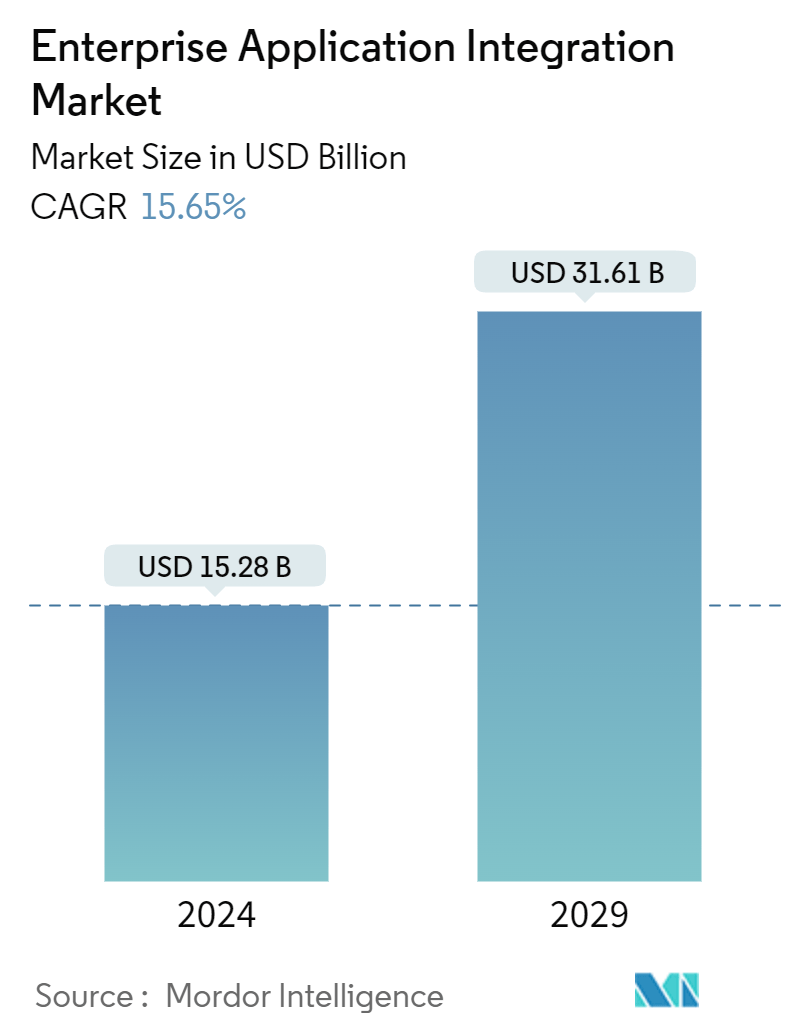
| Study Period | 2019 - 2029 |
| Market Size (2024) | USD 15.28 Billion |
| Market Size (2029) | USD 31.61 Billion |
| CAGR (2024 - 2029) | 15.65 % |
| Fastest Growing Market | North America |
| Largest Market | North America |
Major Players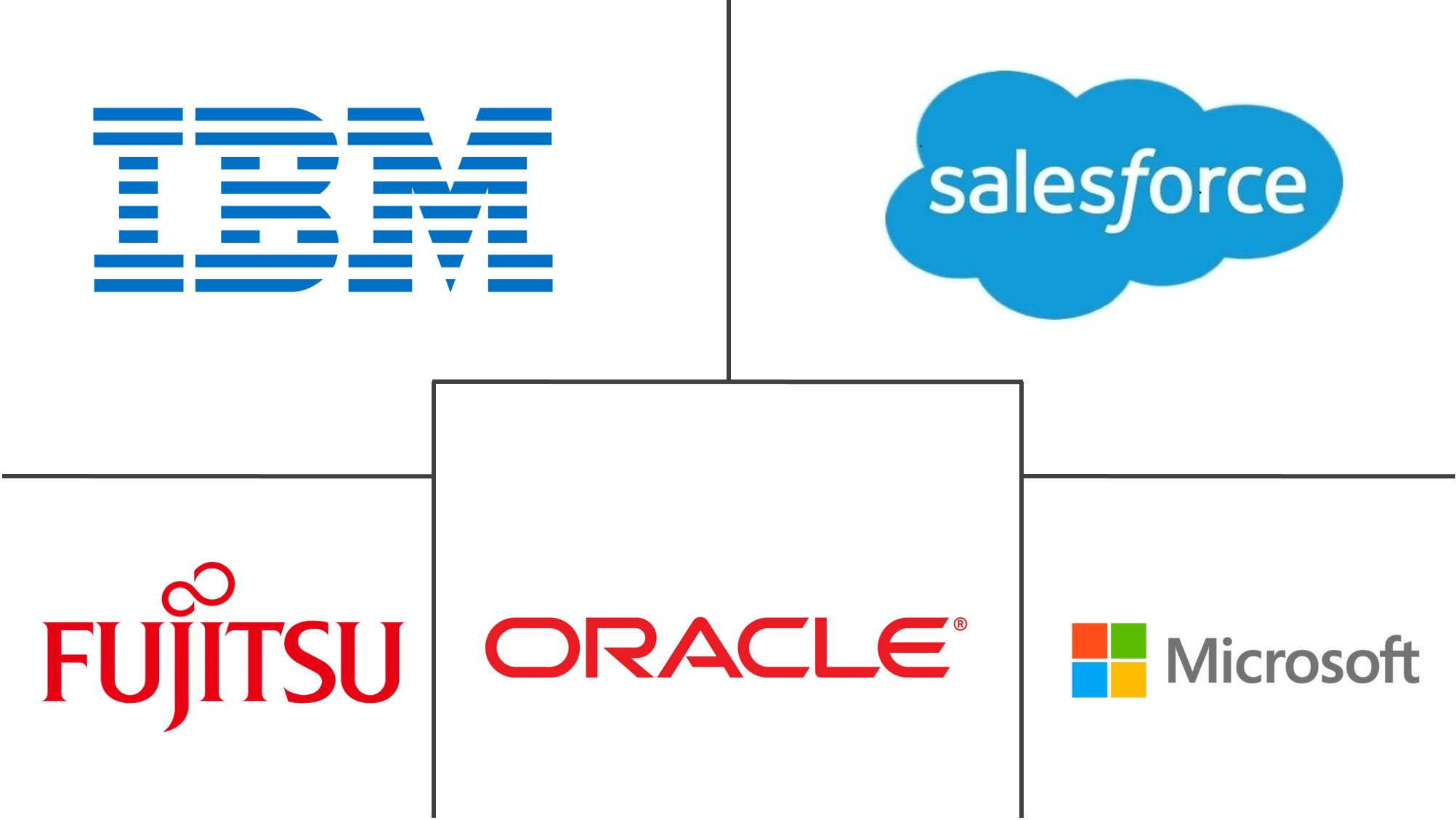
*Disclaimer: Major Players sorted in no particular order |
Enterprise Application Integration Market Analysis
The Enterprise Application Integration Market size is estimated at USD 15.28 billion in 2024, and is expected to reach USD 31.61 billion by 2029, growing at a CAGR of 15.65% during the forecast period (2024-2029).
Digital Transformation Reshaping Enterprise Landscapes
Digital transformation is revolutionizing industries across the board. As businesses evolve, the need for seamless integration of diverse applications becomes paramount. Enterprise Application Integration (EAI) solutions are at the forefront of this transformation, enabling organizations to unify databases and workflows associated with business applications. The adoption of EAI is driven by the increasing complexity of enterprise software ecosystems. According to Okta's "Businesses at Work" report, large organizations deploy an average of 187 applications, showcasing a consistent rise in application utilization globally. This trend underscores the critical need for robust enterprise application integration solutions.
Integration Challenges:
- Disparate Systems: Businesses often operate with incompatible frameworks, hindering data exchange between ERP, CRM, and other critical systems.
- Automation Hurdles: The lack of integration makes automating simple tasks challenging, impacting operational efficiency.
- Financial Impact: Cleo's report reveals that 24% of supply chain companies lose over USD 500,000 annually due to inadequate software system integrations.
EAI Solutions:
- Middleware Infrastructure: EAI introduces a secure platform for open data sharing between heterogeneous applications and legacy devices.
- Unified Approach: By removing data from application restrictions, EAI middleware platforms aid in centralized data management and integration.
- Operational Efficiency: Integration streamlines information sharing and provides ease in controlling data across cloud computing, Big Data, and IoT technologies.
Real-time Data Access: The Cornerstone of Agile Enterprises
The demand for real-time data access and management is surging as businesses strive for agility and operational efficiency. Real-time insights are crucial for making informed decisions, improving customer experiences, and driving personalization efforts. This trend is propelling investments in cloud-based enterprise integration solutions that can handle the complexity and volume of modern data repositories.
Market Response:
- Cloud Connectivity: Qlik introduced Qlik-cloud data connectivity, an Integration Platform as a Service (iPaaS) solution, linking all enterprise data sources to the cloud in real-time.
- On-premise Advantages: On-premise implementations offer real-time monitoring of business operations with enhanced data confidentiality.
- Comprehensive Solutions: Persistent's Enterprise Integration Services enable seamless interfacing of software applications, providing a consistent, real-time view of data across multiple channels.
Industry Impact:
- Performance Optimization: Real-time data integration allows for immediate insights into total business performance across software-defined enterprises.
- Collaborative Efficiency: EAI tools and technologies are evolving to deliver real-time insights, fostering successful cooperation and information exchange across multiple applications.
- Managed Complexity: Single services are emerging to handle issues across a diverse range of infrastructure and applications more effectively.
API-Driven Integration: Powering the Connected Enterprise
The proliferation of mobile applications, IoT devices, and wearables is driving the need for API-centric integration. Real-time, API-driven integration enables the creation of applications that can monitor various parameters on the go, facilitating seamless data flow and synchronization across multiple platforms.
Connectivity Scale:
- Device Proliferation: Cisco projects that 500 billion devices will be connected to the Internet by 2030, emphasizing the critical role of EAI in managing this vast ecosystem.
- Data Synchronization: Real-time application integration ensures data consistency across PCs, laptops, and handheld devices
Enterprise Impact:
- Ecosystem Binding: As digital transformation advances, enterprise software integration is shifting from back-end to a critical role in binding the entire ecosystem.
- Architectural Flexibility: EAI solutions are evolving to support cloud and on-premise environments, agile delivery, and plug-and-play architectures.
Industry-Specific Adoption TrendsThe adoption of EAI solutions varies across industries, with IT and telecom, BFSI, and manufacturing sectors leading the charge. Each sector leverages EAI to address unique challenges and capitalize on emerging opportunities.
IT and Telecom:
- Market Leadership: The IT and telecom segment is projected to reach USD 7.28 billion by 2027, growing at a CAGR of 17.64%.
- Telecom Integration: Enterprise software integration projects are crucial for integrating custom and market application systems in telecom operations, balancing technology with business imperatives.
BFSI Sector:
- Digital Payments: The rise of digital payment methods is driving the need for robust data management systems, fueling EAI market growth.
- Innovative Platforms: BlocPal International Inc.'s development of a unique physical and virtual financial services platform exemplifies the sector's push towards integrated digital solutions.
Manufacturing:
Knowledge Engineering: EAI is critical in integrating dispersed and autonomous manufacturing systems, supporting paradigms like virtual enterprise and mass customization.
- Competitiveness: Efficient application of IT and knowledge-based engineering through EAI enhances firms' ability to respond swiftly to market developments.
- Future Outlook: Evolving Integration Landscape : The future of Enterprise Application Integration is characterized by increasing complexity and the need for more sophisticated, agile solutions. As organizations continue to rely heavily on technology, the demand for integrating diverse applications will only intensify
Emerging Trends:
- Expanded Integration Scope: Future EAI solutions will need to consider a vastly larger collection of endpoints both inside and outside the organization.
- Rapid Innovation: The frequency of changes in integration requirements is accelerating, necessitating more flexible and responsive EAI platforms.
- Mobile Integration: It's projected that 20% of integration spending will be directed towards integrating data on mobile devices, addressing challenges like intermittent connectivity and variable throughput
Strategic Imperatives:
- Balancing Stability and Innovation: IT leaders must maintain control over critical systems while fostering rapid iteration of applications accessing those systems.
- Prefetching and Caching: Mobile apps are increasingly employing sophisticated data prefetching and caching strategies to compensate for connectivity issues.
- Continuous Adaptation: EAI solutions must evolve to support the rapid pace of innovation that distinguishes digital transformation initiatives.
Enterprise Application Integration Market Trends
IT and Telecom Segment: Largest End-User Segment
The IT and Telecom segment emerges as the dominant force in the Enterprise Application Integration (EAI) market, projected to reach USD 7.28 billion by 2027 with a CAGR of 17.64%. The substantial growth underscores the critical role of enterprise software integration solutions in addressing the complex integration needs of the IT and Telecom industries, particularly in the realm of cloud computing and digital transformation.
Cloud Migration Drives Integration Demand:
- Data and Infrastructure Migration: The increasing migration of data, processes, and infrastructure to the cloud by banks and telecom operators is a significant driver for EAI adoption.
- Operational Seamlessness: This shift necessitates robust integration capabilities to ensure seamless operation across diverse systems and applications.
- Cloud-based Focus: Businesses are increasingly prioritizing data platform as a service (dPaaS) over traditional integration platform as a service (iPaaS) models to enhance operational scalability.
Telecom Operators' Core Process Integration:
- Complexity of Integration: Telecom operators are undertaking extensive EAI projects to support core processes, creating middleware infrastructures to integrate custom and market application systems.
- Cross-National Integration: Telecom companies face unique challenges in aligning technical solutions across international subsidiaries, emphasizing the importance of comprehensive integration platforms.
Real-Time Integration and IoT Convergence:
- API-Centric Solutions: The convergence of mobile applications, IoT, and wearables is driving the demand for real-time, API-driven integration solutions.
- Proliferation of Devices: By 2030, projections of 500 billion connected devices emphasize the need for robust integration solutions to manage the data flow across these ecosystems.
Collaborative Software Solutions Drive Integration Needs:
- Virtual Collaboration Surge: The rise of virtual meeting and collaboration tools, such as Microsoft Teams and Zoom, has indirectly boosted demand for integrated enterprise solutions.
- System Interoperability: Businesses are seeking solutions that integrate collaborative software with existing systems, further driving the need for EAI.
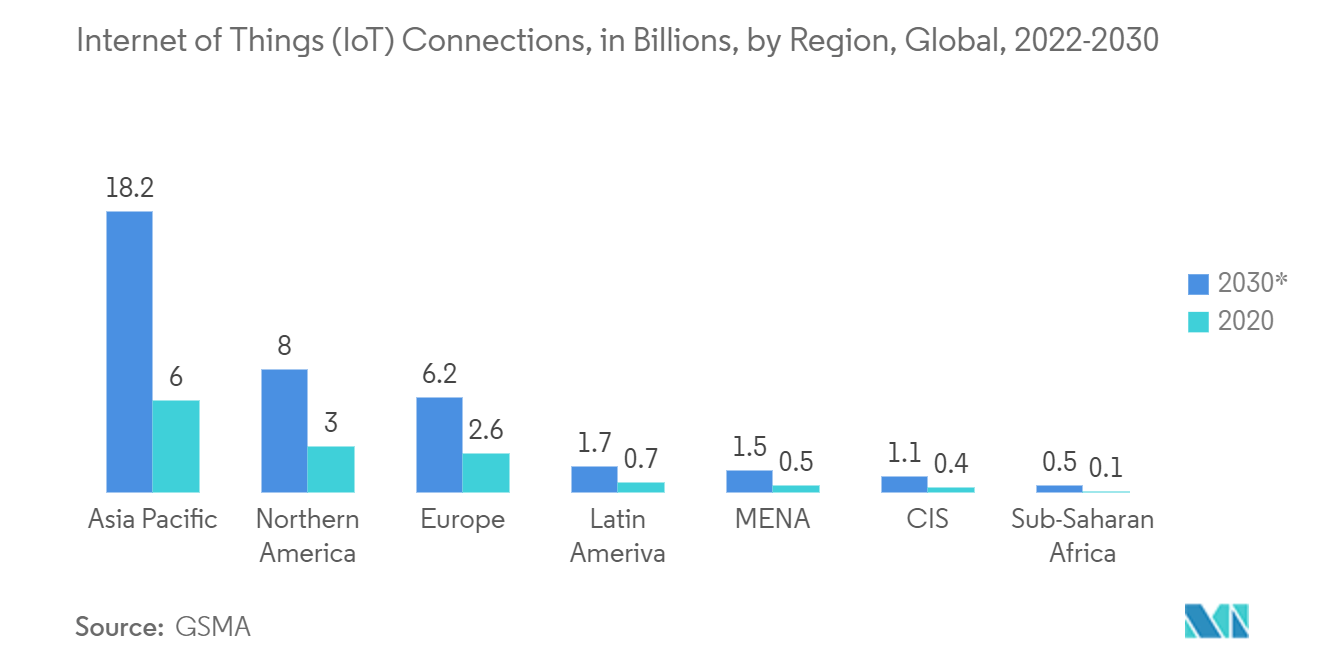
North America: Fastest-Growing Regional Segment
North America stands out as the fastest-growing regional segment in the Enterprise Application Integration (EAI) market, projected to reach USD 14.26 billion by 2027, registering a CAGR of 16.41%. The region's leadership in digital transformation and the widespread adoption of cloud-based enterprise integration solutions highlight its rapid growth trajectory.
Widespread Application Integration:
- High Adoption Rate: Over 93% of U.S. businesses utilize business applications, creating fertile ground for enterprise software integration providers.
- Operational Efficiency: As companies adopt more applications, the demand for seamless integration solutions that enhance operational efficiency continues to grow.
Strategic Alliances and Innovative Solutions:
- Partnerships Driving Innovation: Strategic collaborations, such as HiQ's alliance with the European Cloud City Network and the Frends iPaaS platform, are driving innovation in hybrid cloud integration strategies.
- Regulatory Compliance: These partnerships focus on offering solutions that ensure full compliance with data laws and regulations, critical for public and commercial sector businesses.
Cloud Integration and Digital Transformation:
- Technological Disruptions: The increasing adoption of IoT, cloud computing, and digital transformation initiatives is propelling the demand for EAI solutions across various industries in North America.
- Vendor Focus: Key players in the region, such as IBM and Fujitsu, are leading with innovations like SaaS-based security solutions, driving market growth.
- Consolidated Market: The North American EAI market is moderately consolidated, with global players focusing on cutting-edge technologies to maintain their competitive edge.
- Zero-Trust Architecture: Innovations such as the introduction of zero-trust architecture for security are becoming critical in the deployment of EAI solutions in enterprise environments.
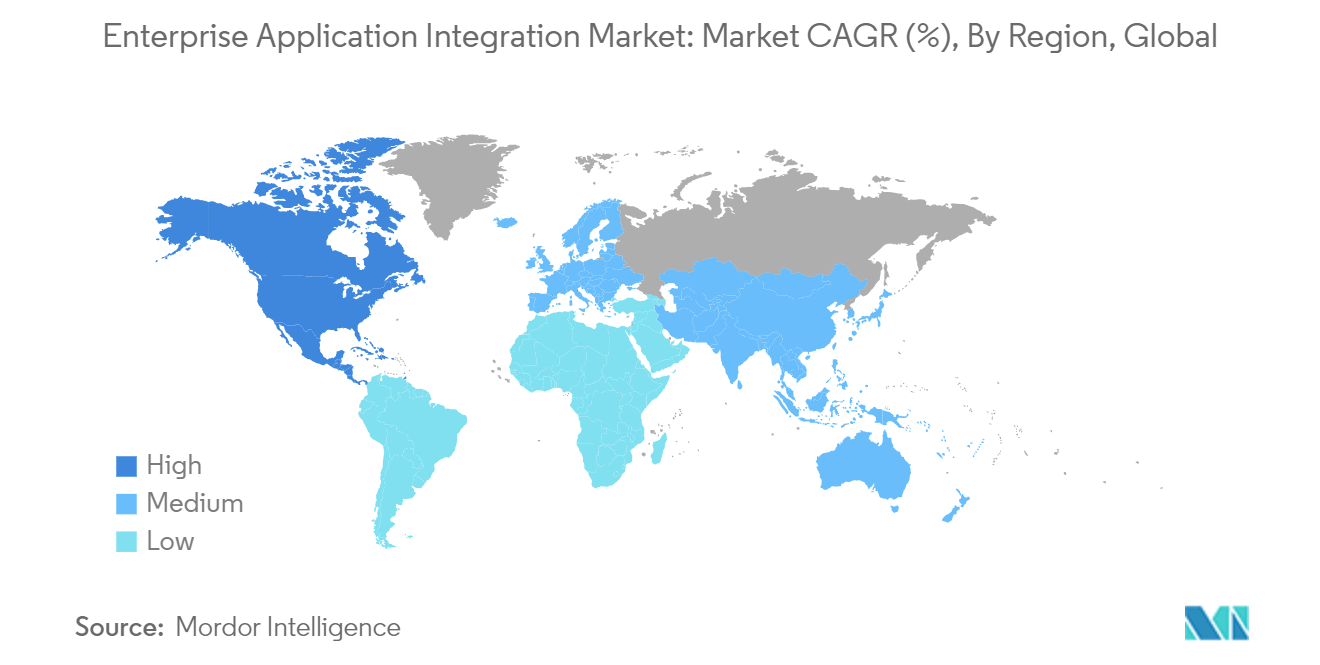
Enterprise Application Integration Industry Overview
Global Players Dominate Semi Consolidated Market
The Enterprise Application Integration (EAI) market is characterized by a semi consolidated structure, with global players such as IBM Corporation, Fujitsu Ltd, and Microsoft holding significant market share. These technology conglomerates leverage their extensive resources, global presence, and technological expertise to dominate the market while smaller, innovative companies carve out niche roles with specialized solutions.
Comprehensive Offerings:
End-to-End Solutions: Global leaders offer comprehensive enterprise application integration solutions that cater to the diverse needs of organizations across industries.
Partnership Ecosystems: Companies like IBM and Microsoft have built extensive ecosystems of partners, enabling them to provide integration across a wide range of business applications and data sources.
Research and Development Focus:
Emerging Technologies: Key players invest heavily in R&D, focusing on innovations in artificial intelligence (AI), machine learning, and cloud computing to advance their EAI platforms.
Support for Hybrid Environments: Their integration solutions are designed to support hybrid cloud integration strategies, ensuring smooth transitions between on-premise and cloud-based infrastructures.
Innovation and Adaptability:
Cloud-Native Architectures: Market players are increasingly shifting towards cloud-native architectures to meet the growing demand for scalable, flexible solutions.
Low-Code/No-Code Tools: The introduction of low-code/no-code tools is expanding the reach of integration capabilities, allowing non-technical users to contribute to data integration services.
Security and Compliance:
Data Privacy Concerns: As enterprises grapple with growing data privacy concerns, EAI vendors and providers are emphasizing security, compliance, and governance features in their solutions to gain a competitive edge.
API Management: Robust API management for EAI is becoming a critical differentiator, allowing organizations to securely integrate a vast number of applications and endpoints.
Enterprise Application Integration Market Leaders
-
IBM Corporation
-
Fujitsu Limited
-
Microsoft Corporation
-
MuleSoft LLC (Salesforce Inc.)
-
Oracle Corporation
*Disclaimer: Major Players sorted in no particular order
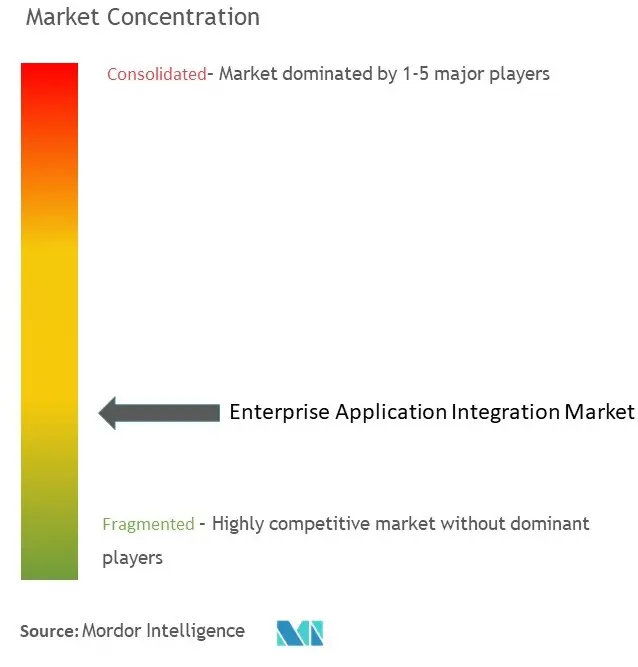
Enterprise Application Integration Market News
- December 2023 - Software AG is changing the way enterprise integration is done by introducing the 'Super iPaaS', a new type of integration platform designed to address the evolving requirements of big, contemporary companies. The 'Super iPaaS' is designed to address the overwhelming challenge of connectivity brought on by rapid digital growth, which current integration tools struggle to handle due to their limited focus on specific capabilities and inability to manage hybrid multi-cloud environments.
- December 2023 - IBM stated that they have made a firm deal with Software AG, mostly owned by Silver Lake, to acquire StreamSets and webMethods, Software AG's Super iPaaS technology platforms. As companies speed up their digital transformations, it is essential to have application and data integration solutions in place for successful application modernization and efficient deployment of AI throughout the company. StreamSets and webMethods are top players in the fields of application integration, API management, and data integration.
Enterprise Application Integration Market Report - Table of Contents
1. INTRODUCTION
- 1.1 Study Assumptions and Market Definition
- 1.2 Scope of the Study
2. RESEARCH METHODOLOGY
3. EXECUTIVE SUMMARY
4. MARKET INSIGHTS
- 4.1 Market Overview
- 4.2 Industry Value Chain Analysis
-
4.3 Industry Attractiveness - Porter's Five Forces Analysis
- 4.3.1 Threat of New Entrants
- 4.3.2 Bargaining Power of Buyers
- 4.3.3 Bargaining Power of Suppliers
- 4.3.4 Threat of Substitutes
- 4.3.5 Degree of Competition
- 4.4 Technology Snapshot
5. MARKET DYNAMICS
-
5.1 Market Drivers
- 5.1.1 Digital Transformation Reshaping Enterprise Landscapes
- 5.1.2 Increasing Demand for Real-time Data Access and Management
- 5.1.3 API-Driven Integration Powering the Connected Enterprise
-
5.2 Market Challenges
- 5.2.1 Availability of Open Source Software
- 5.2.2 The lack of integration makes automating simple tasks challenging, impacting operational efficiency.
- 5.3 Assessment of Impact of COVID-19 on the Industry
6. MARKET SEGMENTATION
-
6.1 Deployment Type
- 6.1.1 On-premise
- 6.1.2 Cloud
- 6.1.3 Hybrid
-
6.2 Organisation Size
- 6.2.1 Large Enterprises
- 6.2.2 Small and Medium-sized Enterprises
-
6.3 End-user Industry
- 6.3.1 BFSI
- 6.3.2 IT and Telecom
- 6.3.3 Healthcare
- 6.3.4 Retail
- 6.3.5 Government
- 6.3.6 Manufacturing
- 6.3.7 Other End-user Industries
-
6.4 Geography
- 6.4.1 North America
- 6.4.2 Europe
- 6.4.3 Asia Pacific
- 6.4.4 Latin America
- 6.4.5 Middle East and Africa
7. COMPETITIVE LANDSCAPE
-
7.1 Company Profiles*
- 7.1.1 IBM Corporation
- 7.1.2 Fujitsu Limited
- 7.1.3 Microsoft Corporation
- 7.1.4 MuleSoft LLC (Salesforce Inc.)
- 7.1.5 Oracle Corporation
- 7.1.6 SAP SE
- 7.1.7 Software AG
- 7.1.8 Tibco Software Inc.
- 7.1.9 iTransition Group
8. INVESTMENT ANALYSIS
9. FUTURE OF THE MARKET
** Subject To AvailablityEnterprise Application Integration Industry Segmentation
Enterprise application integration software refers to server software, hardware, or virtual appliances installed on-premise inside a data center, or offered in a public or private cloud, to integrate applications. It handles the workflow or orchestration of automated multistep requests requiring coordinated interactions across applications, back-end services, and data stores. The study tracks the various types of integration platforms to support on-premise, cloud, and iPaaS (integration Platform-as-a-Service) and end users in the market.
The enterprise application integration market is segmented by deployment type (on-premise, cloud, hybrid), by organization size (large enterprises, small & medium-sized enterprises), by end-user industry (BFSI, IT & telecom, healthcare, retail, government, manufacturing), and by geography (North America, Europe, Asia-Pacific, Latin America, Middle East & Africa). The market sizes and forecasts are provided in terms of value (USD) for all the above segments.
| Deployment Type | On-premise |
| Cloud | |
| Hybrid | |
| Organisation Size | Large Enterprises |
| Small and Medium-sized Enterprises | |
| End-user Industry | BFSI |
| IT and Telecom | |
| Healthcare | |
| Retail | |
| Government | |
| Manufacturing | |
| Other End-user Industries | |
| Geography | North America |
| Europe | |
| Asia Pacific | |
| Latin America | |
| Middle East and Africa |
Enterprise Application Integration Market Research FAQs
How big is the Enterprise Application Integration Market?
The Enterprise Application Integration Market size is expected to reach USD 15.28 billion in 2024 and grow at a CAGR of 15.65% to reach USD 31.61 billion by 2029.
What is the current Enterprise Application Integration Market size?
In 2024, the Enterprise Application Integration Market size is expected to reach USD 15.28 billion.
Who are the key players in Enterprise Application Integration Market?
IBM Corporation, Fujitsu Limited, Microsoft Corporation, MuleSoft LLC (Salesforce Inc.) and Oracle Corporation are the major companies operating in the Enterprise Application Integration Market.
Which is the fastest growing region in Enterprise Application Integration Market?
North America is estimated to grow at the highest CAGR over the forecast period (2024-2029).
Which region has the biggest share in Enterprise Application Integration Market?
In 2024, the North America accounts for the largest market share in Enterprise Application Integration Market.
What years does this Enterprise Application Integration Market cover, and what was the market size in 2023?
In 2023, the Enterprise Application Integration Market size was estimated at USD 12.89 billion. The report covers the Enterprise Application Integration Market historical market size for years: 2019, 2020, 2021, 2022 and 2023. The report also forecasts the Enterprise Application Integration Market size for years: 2024, 2025, 2026, 2027, 2028 and 2029.
Enterprise Application Integration Industry Report
Enterprise Application Integration Market Research
Our industry research report provides a comprehensive analysis of the Enterprise Application Integration (EAI) market, offering deep insights into emerging trends, technologies, and sector-specific adoption patterns. The report covers key aspects such as API management, middleware platforms, and cloud-based integration, enabling businesses to stay ahead of market developments. By focusing on real-time data integration, EAI tools, and technologies, we help organizations optimize operational efficiency and enhance connectivity across applications. All findings are available in an easy-to-read report pdf format, providing stakeholders with critical data to make informed decisions.
Stakeholders benefit from our detailed examination of EAI's impact across various industries, including IT, telecom, BFSI, and manufacturing. The report highlights integration strategies, industry-specific solutions, and future growth drivers. From cloud-native architectures to low-code integration platforms, our research explores the evolution of EAI solutions and the opportunities they present. Businesses will find actionable insights into the industry's technological advancements, offering a competitive edge in navigating the complexities of enterprise software integration.



